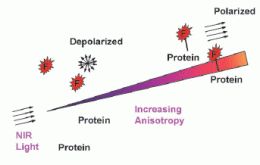New dye could open the door to in vivo applications of fluorescence anisotropy

(PhysOrg.com) -- US scientists have synthesized a polymethine dye that can be used for fluorescence anisotropy imaging in the near-infrared (NIR) spectral range, making new in vivo applications of this technique possible. Until now, the method has been limited to the visible part of the spectrum, mainly being used in drug selection and quality control of protein labeling. "Due to the deep penetration of near-infrared photons in biological tissues, fluorescence anisotropy could now be potentially utilized to monitor the behavior of drugs in living organisms", says Professor Mikhail Y. Berezin (Washington University), one of the authors of the work published in ChemPhysChem.
Fluorescence anisotropy - also known as fluorescence polarization - is an optical technique widely applied in biochemistry and drug discovery. It uses polarized light to measure the rotation of molecules in solutions. Large molecules, such as proteins, rotate slower than small molecules, and hence show larger fluorescence anisotropy values. NIR probes which absorb and emit light within the range from 700-900 nm have several benefits in biological studies, including reduced interference from endogenous fluorophores and lowered hindrance from light scattering encountered with screening.
"While in theory the method can be applied to a fluorophore in any spectral range, fluorescence anisotropy has long been limited to a visible part of the spectrum", Berezin explains. "Although this limitation was in part due to a poor sensitivity of existing detectors to near-infrared photons, the major challenge lied in the absence of an appropriate fluorophore", he says. According to the author, commercially available NIR probes, such as Cy7 and IR800CW, have relatively long linkers, which leads to incomplete immobilization of the fluorescent probe on the macromolecule of interest and therefore to a higher local mobility - or "wobbling" - of the fluorophore (propeller effect).
To overcome this problem, the team synthesized a new NIR fluorescent label with the desired photophysical properties. They demonstrated that the polymethine dye LS601 has all the required properties to be used as an appropriate label in anisotropy applications. It exhibits a relatively long fluorescence lifetime, a short linker to minimize the low local mobility and can be easily conjugated to biomolecules under aqueous conditions. "Based upon our results we believe that fluorescence anisotropy in the NIR range will find a number of applications in drug discovery, fluorescence polarization imaging and contrast-agent development", the researchers report.
More information: Mikhail Y. Berezin, Defining a Polymethine Dye for Fluorescence Anisotropy Applications in the Near-Infrared Spectral Range, ChemPhysChem, Permalink to the article: dx.doi.org/10.1002/cphc.201100916
Journal information: ChemPhysChem
Provided by Wiley















